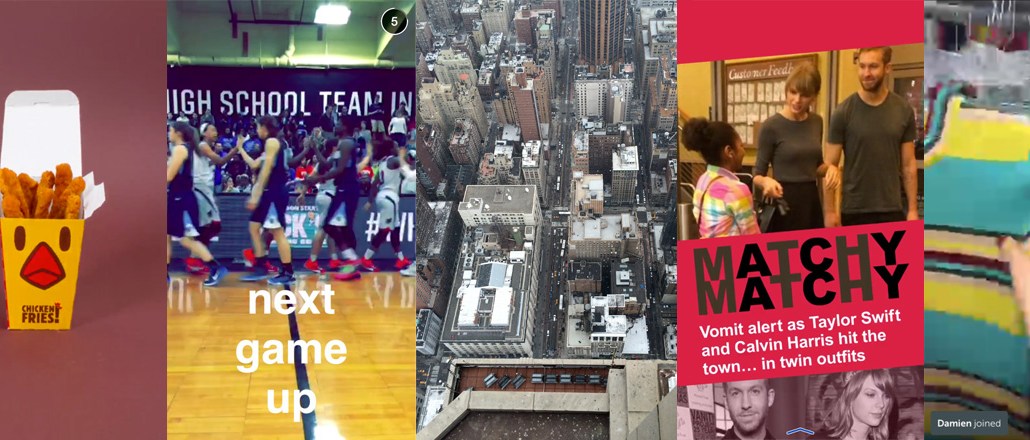Save 50% on a 3-month Digiday+ membership. Ends Dec 5.
‘It’s unnatural’: What agency creatives really think about vertical video

Last week wasn’t a good time to be a vertical video hater.
First, in a mind-numbingly boring presentation tailored to doddering CMOs everywhere, Evan Spiegel last week released a new video to go along with his Cannes Lions presentation touting “3V videos.” (The three “Vs” stand for vertical, video and views.) Also at Cannes, Facebook showed off a new video-rich ad format that also uses vertical video for mobile.
And the Daily Mail, Snapchat and WPP banded together to create an entire agency for vertical video. “Truffle Pig” will help brands develop and shoot videos for Snapchat and other platforms. Speaking at a presentation in Cannes announcing the agency, Daily Mail CEO Jon Steinberg said that in the future, all video will be vertical.
But not everyone is on board. One agency creative told Digiday on condition of anonymity because his clients were gung-ho on Snapchat that he “hated” making videos vertical. “There’s no art to it. It’s haphazard.” His creative partner, an art director, agreed: “Your eyes move side to side, not up and down,” he said. “It’s unnatural.”
Ben James, executive creative director at JWT New York, said that his big aha moment came when he talked to Zack Roif, an art director with 70,000 Instagram followers. James used to think building an audience on platforms like Snapchat and Instagram was about when to post and how. Then, he said, he realized it was about creatively using the platform — vertical or not. “We started talking about a feature film shot in vertical. I don’t think I would like that,” he said. “But he really wants to see one. And he’s a millennial, so it’ll happen sooner or later.”
“Anyone obsessing over the limitations of mobile vertical doesn’t have enough to do,” said FCB Chicago creative chief Todd Tilford, who said that while plenty of people may whine over its perceived limitations, there are new creative uses for it.
John Patroulis, creative chairman at BBH, said that because all other screens in the world are horizontal, audiences may feel like vertical video is less appealing. But there are new possibilities: “If anyone is too upset by having to frame things differently or figuring out ways to take advantage of that new way to experiencing moving images, they are going to really be bummed when virtual reality gets more popular, or when someone tells them they have to shoot something in 3D.”
Ad position: web_incontent_pos1
At most agencies, dealing with vertical video has landed smack-dab in the content departments. And it’s the job of strategists to convince unhappy creatives to just deal with it. “I’ve heard creatives who find it restrictive,” said Noah Mallin, head of social at MEC North America. “My point of view is, we’re in the business of telling stories, so just be flexible. It’s an ongoing push and pull.” Creatives also think vertical video is one more ask added to a laundry list of client demands in digital. “The resources it takes to be successful in digital are very high,” said Mallin. Indeed — the changing nature of the work and the increasing number of deliverables are one of the major reasons why agency employees report being increasingly unhappy.
At VaynerMedia, creative director Jason Beauregard said that the company baked doing vertical video into its creative process right when Snapchat opened up to ads. The agency uses high-quality cameras to shoot vertical videos (as opposed to just phones) and places extra emphasis on composition, which Beauregard said is more important with this format. And one more factor — the relative youth of everyone in the agency — helped: “It wasn’t difficult incorporating it since we were so familiar with vertical video from using it in our personal lives,” he said.
More in Marketing

Ulta, Best Buy and Adidas dominate AI holiday shopping mentions
The brands that are seeing the biggest boost from this shift in consumer behavior are some of the biggest retailers.

U.K. retailer Boots leads brand efforts to invest in ad creative’s data layer
For media dollars to make an impact, brands need ad creative that actually hits. More CMOs are investing in pre- and post-flight measurement.

‘AI is permeating everything we do’: How Guitar Center developed 2 AI tools this year
This summer, the company launched a chatbot called Rig Advisor to help customers find the right instruments and products.
Ad position: web_bfu
